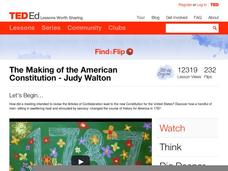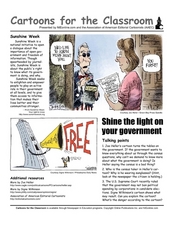TED-Ed
The Making of the American Constitution
What a fun way to learn about the making of the American Constitution! This video does a great job of describing the circumstances that existed for the delegates in Philadelphia in 1787, where in a just a few days, they would effectively...
Center for Civic Education
What Basic Ideas About Government Are Included in the Preamble to the Constitution?
Young historians explore the meaning of the Preamble to the US Constitution in this upper-elementary social studies lesson. Working with partners or in small groups, children discuss the purpose of government before reading and analyzing...
Center for Civic Education
What Basic Ideas Are in the Preamble to the Constitution?
Introduce young historians to the US Constitution with this upper-elementary social studies lesson plan. Beginning with a general discussion about the role of government in society, learners go on to work in small...
Curated OER
Our Classroom Constitution
Develop a system of classroom rules created by the kids, for the kids with this three-part lesson series on the US Constitution. After learning about the structure of the Constitution and the government it established, young...
Read Works
A Constitution for Kids
What better day to celebrate the US Constitution than on Constitution Day! After reading a short passage about the different understandings of habeas corpus and ex post facto, sixth graders respond to 10 multiple choice and short...
TED-Ed
Why Is the US Constitution so Hard to Amend?
Over 11,000 amendments have been proposed for the US Constitution, yet only 27 have peen ratified. This short video explains why.
TED-Ed
Why Wasn’t the Bill of Rights Originally in the US Constitution?
Did you know that the Bill of Rights was not added to the US Constitution until three years after the Constitution was adopted? This short video explains why these fundamental protections for individual liberties were added as the first...
TED-Ed
A 3-Minute Guide to the Bill of Rights
If you don't have the time to spend an entire class on the Bill of Rights, or you are looking for a simple overview, this video provides clear and illustrated descriptions of each of the first ten amendments to the Constitution. You may...
Curated OER
Cartoons for the Classroom: Shine the Light on Your Government
What don't we know about our government? Explore the concept of transparency and freedom of information throught this analysis handout, in which scholars examine 2 political cartoons. Background information provides context, explaining...
Curated OER
Cartoons for the Classroom: The Constitutional Battleground
In this primary source analysis learning exercise, students analyze political cartoons about the Supreme Court and Constitutional issues and respond to 5 talking point questions.
TED-Ed
How You Could Get Away with Murder in Yellowstone’s “Zone of Death"
Looking for loopholes in the Constitution? Watch a video that describes how one could get away with a crime in the "Zone of Death." Because Yellowstone National Park is considered to be federal land, and it is technically in three...
Center for Civic Education
What Is Authority?
Young scholars examine the concepts of power and authority as they begin learning about government in this elementary social studies lesson. Through a series of readings, discussions, and problem solving activities, children...
Curated OER
Proposition 8 Struck Down
Have your class examine the issues surrounding same-sex marriage, civil rights, and proposition 8. They read a New York Times article entitled "Proposition 8 Struck Down" and then answer 10 who, what, when, where, and why questions....
TED-Ed
The Historical Audacity of the Louisiana Purchase
In order to double the size of the country and make what would become the greatest real estate deal in the history of the United States, Thomas Jefferson had to set aside his beliefs in small government and his strict constructionist...
Crash Course
Where US Politics Came From
After the passage of the United States Constitution, the founding fathers faced a difficult question: What kind of country should we be? How democratic should we be, and much free speech should we have? Discover the different visions...
TED-Ed
Einstein's Miracle Year
Why was Albert Einstein initially labeled as a "failed" academic, and what events occurred in 1905 that constituted a major turning point for this great scientist? Review Einstein's major theories regarding relativity, light...
K12 Reader
What is a Tribal Government?
What is life like on a Native American reservation? Learn about the ways a tribal government works with a reading comprehension activity. After reading a short passage, kids use context clues to answer five comprehension questions.
K12 Reader
Responsibilities of Citizenship
Your pupils are all citizens of your classroom. Provide some more instruction on how people can be citizens with the reading passage included here. After reading, learners answer the five related questions.
Curated OER
Cartoons for the Classroom: Why is Freedom of Speech a Burning Issue?
In this current events worksheet, students analyze a political cartoon about the freedom of speech and respond to three short answer questions
Crash Course
Legal System Basics: Crash Course Government and Politics #18
Do the courts only exist to punish people? Scholars investigate the many roles the criminal justice system plays in the United States government and politics. They research a short video clip to better understand and analyze the role the...
TED-Ed
The Historic Women’s Suffrage March on Washington
March 3, 1913, thousands of women marched on Washington D.C. to demand the right to vote. Learn about the organizers and leaders of the protest with a short video that details how the protest reignited the fight for voting rights and...
TED-Ed
How Does Caffeine Keep Us Awake?
You might want to put down your coffee for this one. Discover the science behind this stimulant, its origins, side-effects, and benefits of the most widely used drug: caffeine.
Crash Course
Election Basics: Crash Course Government and Politics #36
The candidate with the most votes wins ... right? A short video clip opens up thought and discussion on the basics behind elections and how citizens decide the victor. The concept of political parties and securing votes are at the center...
TED-Ed
How is Power Divided in the United States Government?
Need an introduction to the three branches of the United States government? Look no further! This video offers a basic breakdown of the legislative, judicial, and executive branches, including their general makeup and designated...
Other popular searches
- Constitution Week Worksheets
- Constitution Week Video
- Constitution Week Booklet
- Constitution Week Using Art
- Constitution Week Review
- Constitution Week Book
- Explorers Constitution Week

























